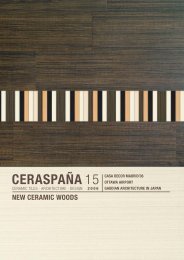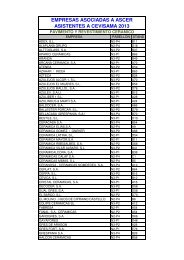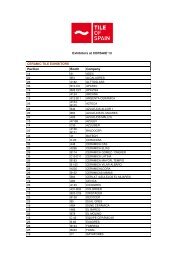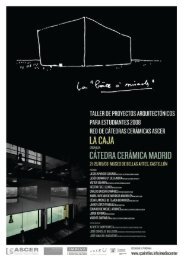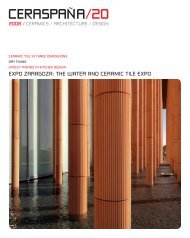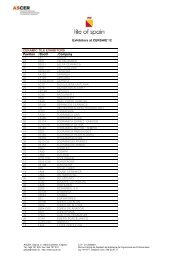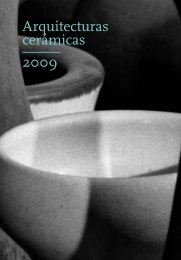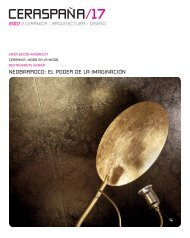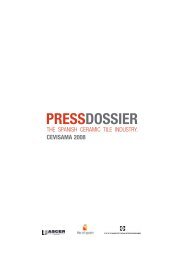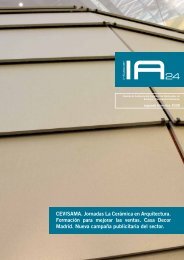PRESS DOSSIER CEVISAMA 2009 - Tile of Spain
PRESS DOSSIER CEVISAMA 2009 - Tile of Spain
PRESS DOSSIER CEVISAMA 2009 - Tile of Spain
You also want an ePaper? Increase the reach of your titles
YUMPU automatically turns print PDFs into web optimized ePapers that Google loves.
<strong>PRESS</strong> <strong>DOSSIER</strong> <strong>2009</strong>5
Holland, Hungary, India, Italy, Korea, Lithuania, Poland, Romania,Russia, Ukraine and the United Kingdom. The architectureworld’s growing interest in ceramic wall and floor tiles, whichare providing ever more construction solutions means that asignificant number <strong>of</strong> the journalists invited are from architecturemagazines. The international press visitor programme has beenrun in previous years and, given the success achieved as a result<strong>of</strong> the invited press’ knowledge <strong>of</strong> and engagement with theSpanish tile industry, it has become one the main mechanics forpromoting the industry to specifiers internationally.ASCER will once again be holding its traditional international pressconference where it will reveal the Spanish ceramic tile industry’smain results and the projects set to be rolled out over the year thathas just begun. Following the conference the winners <strong>of</strong> the VIIth <strong>Tile</strong><strong>of</strong> <strong>Spain</strong> Awards will be announced, with prizes being given in thefollowing categories: Architecture, Interior Design, Degree Projectsand Journalism.6
<strong>PRESS</strong> <strong>DOSSIER</strong> <strong>2009</strong>The growth has been sustained primarily by sales to Europe(+12.3%), which account for two thirds <strong>of</strong> our exports. Sales tothe markets <strong>of</strong> Eastern Europe experienced particularly stronggrowth (with Russia, our fourth largest export market, in thelead at +19.1%) as did exports to the new EU member states(led by Romania at +35.5%). France showed positive growthtoo (+10.7%) and is our biggest customer following the decline<strong>of</strong> exports to the U.S. (-34.4%), whilst sales to Italy and Greecewere more than 20% up. Exports to Africa continue to performvery positively at +16.4%. In the difficult market <strong>of</strong> the FarEast sales rose 5.6% but, in sharp contrast, exports to Americawere down, exports to the Middle East rose by a mere 1.6% andsome important European markets such as Germany, Portugaland the United Kingdom performed worse than the rest <strong>of</strong> theContinent.SPAIN’S CERAMIC TILE INDUSTRY IN 2007Production- 584.7 million m2- EU share: 38.5%- 94% <strong>of</strong> domestic outputis concentrated in theprovince <strong>of</strong> CastellónDomestic sales- 1.871 million €Employment- 25.000 in directemployment- 5.000 employed indirectlyExports- to 177 countries- 2.295 million €- Share <strong>of</strong> total worldtrade: 19%:Imports- 156 million €Total sales- Estimated value:4,166 million €THE DOMESTIC MARKET is estimated to have grown 4%in 2007, with sales valued at 1,871 million euros. <strong>Spain</strong> isEurope’s biggest consumer <strong>of</strong> ceramic tiles and has the highestper capita rate <strong>of</strong> consumption in the world.IMPORTS IN 2007 were valued at 156.8 million euros, 27% upon the previous year, although the rate <strong>of</strong> growth slowed across2008. The main supplier countries, in order, are Italy, China andPortugal. It is estimated that only 5% <strong>of</strong> domestic consumptionis catered for by imports.According to estimates, the ceramic tile industry comprisedaround 200 manufacturers in 2007. Twenty or so companiesspecialising in atomising clay and making biscuit should beadded to this figure. <strong>Spain</strong>’s ceramic tile sector as a wholeprovides direct employment for approximately 25,000 workersand is reckoned to generate more than 5,000 indirect jobsin companies that are on the whole small and medium sizedenterprises.One <strong>of</strong> the salient features <strong>of</strong> the Spanish ceramic tile industryis that it is highly concentrated geographically in the province<strong>of</strong> Castellón, particularly in the area that is bounded by Alcoraand Borriol to the north, Onda to the west, Nules to the southand Castellón de la Plana to the east. The sector makes upan industrial “cluster” or district and comprises a number <strong>of</strong>ancillary industries and related organisations in a specificgeographical area.FORECAST FOR THE FINANCIAL YEAR 2008It is estimated that the total amount <strong>of</strong> sales <strong>of</strong> the Spanish ceramictiles industry for the financial year 2008 has reached 3,700 millionEuros. This figure represents a decrease <strong>of</strong> 11.4% compared withthe previous year.60% <strong>of</strong> the total sales were focused on the international markets,what confirms again the exporter potential <strong>of</strong> the Spanish ceramictiles industry. This sector is ranked as one <strong>of</strong> the twelve top mainSpanish exporters. Foreign sales are estimated by the market value<strong>of</strong> 2,230 millions Euros (-2.8%).Sales in the national market during 2008 represented 40% <strong>of</strong> thetotal amount <strong>of</strong> sales, that is to say, an estimated decrease <strong>of</strong> 22%,rising to 1,460 million Euros.WHAT IS ASCER?ASCER is the Spanish Ceramic <strong>Tile</strong> Manufacturers’ Association,a body that provides support to and defends and promotes theinterests <strong>of</strong> the Spanish ceramic tile industry. Today, almost all thesector belongs to ASCER, which means that it represents a very highproportion <strong>of</strong> the industry.One <strong>of</strong> the features <strong>of</strong> <strong>Spain</strong>’s ceramic tile industry is that it isimmensely dynamic and in constantly moving forward. Because <strong>of</strong>this ASCER rolls out a multitude <strong>of</strong> activities designed to promoteceramic tiles and improve understanding <strong>of</strong> the product amongstspecifiers and the end user both in <strong>Spain</strong> and internationally.9
CERAMIC:A SUSTAINABLE, CUTTINGEDGE MATERIALBy its very nature and by virtue <strong>of</strong> its production process,ceramic tile is a sustainable material. The raw materials that gointo a ceramic tile being used in a project come from the earth(clay) and, together with water and the heat used for firing makea natural, high quality product.Clay is a natural raw material whose properties and naturemean that, since time immemorial, it has been linked to man’sdevelopment, to his drive to improve his living conditionsand the comfort <strong>of</strong> his environment. Archaeology identifiesclay as a systematic record <strong>of</strong> how the cultures <strong>of</strong> antiquityevolved and an example <strong>of</strong> man’s progress through the ages.This material has always been and is even now a vehicle forman’s technological development, a measure <strong>of</strong> his degree <strong>of</strong>civilisation and the maximum expression <strong>of</strong> his culture.The ceramic tile industry’s investment in R, D + I has broughtabout the application <strong>of</strong> new technology, increasing efficiencyand saving resources in the manufacturing process. Theceramic tile sector has thus managed to reduce its energyconsumption whilst maintaining the same levels <strong>of</strong> output, tothe extent that it achieves the best ratios <strong>of</strong> energy efficiencyto units produced <strong>of</strong> any tile manufacturing industry in theworld.<strong>Spain</strong>’s ceramic tile industry has also pioneered usingco-generation in order to increase efficiency and savings inits manufacturing processes. The technique was introducedin the mid 1980s and has achieved overall efficiency ratesabove 75% and primary energy savings above 10%. There arecurrently more than 80 co-generation facilities up and runningthat contribute 1,500 GW a year for the ceramic tile industryto use. Co-generation is one <strong>of</strong> the so-called “best techniquesavailable”. <strong>Spain</strong>’s tile sector uses these techniques inorder to be more energy efficient and more environmentallyresponsible.made in this area have resulted in the sector’s water/m2consumption ratio being lower than that stipulated as being theoptimum by the European industry and, in many cases, to zerodischarge,which has helped improve the quality <strong>of</strong> our waters.One <strong>of</strong> the fields in which the Spanish ceramic tile industry isinvesting the most effort is waste management. In the stages<strong>of</strong> the production process prior to firing, 100% <strong>of</strong> waste can bere-used as it can be put back into the raw material preparationcircuit. Once the firing process has been completed any wasteproduced can be either ground up and used as a covering orground up and put back into the manufacturing process. Inconstruction and demolition waste tiles can also be recycledand used as a base or sub-base for flooring or as cementpowder. The industry is working along these lines in order toachieve “zero waste”.THE ECO* TRENDThe Eco trend is characterised by a significant ethical and socialemphasis that lies behind a whole series <strong>of</strong> products, projectsand spaces designed to enhance living conditions. The issue <strong>of</strong>how we interact with our environment, with society in general andwith the individual in particular is being re-visited in relation toacknowledging social and environmental responsibility.HOW THIS IS BEING MANIFESTED:- Sustainable products.- Close to nature: a creative rapprochement <strong>of</strong> natureand the habitable space.- The Community: designs that relate to universal orinclusive and social design.Sensible use <strong>of</strong> water is also on the Spanish ceramic tileindustry’s environmental agenda. The efforts that have been* Source: Notes on Trends in the Home 08-09 compiled by theObservatory for Trends in the Home ®10
<strong>PRESS</strong> <strong>DOSSIER</strong> <strong>2009</strong>The ceramic tile industry has been investing so as to be ableto put measures in place that will contribute to sustainabledevelopment and, at the same time, be compatible with healthand the environment. ASCER is pursuing its aim <strong>of</strong> being at thetechnological forefront <strong>of</strong> the global ceramic tile industry, whilstalso being a point <strong>of</strong> reference with regard to the environmentand existing alongside the society that surrounds it.THE MOST ECO CERAMIC:- The raw materials that make up ceramic tiles come fromthe earth and, together with water and the heat used forfiring them, make a natural, high quality product.- Ceramic is a material that is resistant to the passage<strong>of</strong> time.- Ceramic floor an wall tiles are waterpro<strong>of</strong>.- Ceramic achieves considerable energysavings when used on facades (ventilated facades)and ro<strong>of</strong>s.- Ceramic can achieve highly sustainable life cycles.The industry is investing in research into how the materialcan be recycled.11
TILE OF SPAIN ANDINNOVATIONThe Spanish ceramic tile sector is remarkable on two counts:its capacity for innovation and the amount <strong>of</strong> research itundertakes that leads it to develop new solutions for majorarchitectural projects and for all <strong>of</strong> our homes. The followingare some <strong>of</strong> the most interesting propositions that combinetechnology and ceramic materials to service our needs.PHOTOVOLTAIC PANELSCurrent sensitivity regarding issues that affectthe environment, such as alternative energy, has hadrepercussions in the ceramic tile sector. As a result, systemshave been developed that use the latest technologicalinnovations to incorporate photovoltaic cells into ceramictile facades, in the same modular way as tiles are installedand using the same fixing systems. There are even systemsthat encapsulate photovoltaic cells into the ceramic tilesthemselves.TILES FOR EXTERIORSThis family <strong>of</strong> products comprises high durability floor tiles forexterior spaces that are designed to afford safety and comfortto citizens. They are designed to be suitable for a greatdiversity <strong>of</strong> urban projects, which is why their properties area far remove from the rigidity <strong>of</strong> a single regular format. Thetile’s robustness is created by modifying the geometry <strong>of</strong> thereverse <strong>of</strong> the tile, based on an analysis <strong>of</strong> tensions calculatedfrom finite elements. The aim is to strengthen the mostvulnerable areas asymmetrically, even where the conditionsin which the tile is to be installed are not favourable. <strong>Tile</strong>scan be adapted to create a wide range <strong>of</strong> products and areavailable as floor tiles in a great variety <strong>of</strong> graphic finishes,colours and textures.BENDING TILESCeramic tiles can be shaped as the project in question requires.One very useful possibility is bending them. This systemconsists <strong>of</strong> placing the fired tiles on a suitable support andtaking them through a kiln so that the temperature gives theceramic a plastic consistency.Ceramic pavementsDIGITAL PRINTINGOne <strong>of</strong> the advances in R, D + I processes that <strong>of</strong>fers the mostpossibilities is digital printing onto ceramic. The system meansthat tiles can be personalised with any image we choose, therebycreating a unique and unusual design for both exteriors andinteriors.TRANSLUCENT CERAMICTranslucent vitreous tiles made by synthesising frit particlesavailable in a wide diversity <strong>of</strong> colours. These tiles bring naturallight and exclusive colour to any space in which they are used.An innovative option that promotes the creation <strong>of</strong> light filled,welcoming spaces.TILES AND HOME AUTOMATIONBy applying the latest technological innovations to ceramicmaterials the Spanish ceramic tile industry has been able todevelop tiles that, as well as their own intrinsic properties, <strong>of</strong>fernew functionalities that are in line with current home automationsystems.As the fingers make contact with the surface <strong>of</strong> the tile this triggersa reaction (touch-sensitive tiles). The positioning <strong>of</strong> the tile on thewall, at an appropriate height, large-size icons and including text inbraille contribute towards achieving accessibility for all , one <strong>of</strong> theprinciples <strong>of</strong> Universal Design.12
<strong>PRESS</strong> <strong>DOSSIER</strong> <strong>2009</strong><strong>Tile</strong>s decorated by Ink-jet process13
TILE OF SPAIN AWARDS OFARCHITECTURE ANDINTERIOR DESIGNThe seventh competition for the <strong>Tile</strong> <strong>of</strong> <strong>Spain</strong> Awards was heldin 2008, with the prizes already an established fixture on<strong>Spain</strong>’s architectural landscape. Almost 100 projects wereentered across the competition’s three main categories: Architecture,Interior Design and Degree Projects.When the jury for the VIIth <strong>Tile</strong> <strong>of</strong> <strong>Spain</strong> Awards met it decidedunanimously to award the competition’s first prize in the architecturecategory to the “Spanish Pavilion at Expo Zaragoza 2008” byarchitect Francisco Mangado. Chaired by Terence Riley, director <strong>of</strong>the Miami Art Museum and architecture expert, the jury also decidedto award an Honorary Mention to the “Villa Nurbs” project for a familyhouse in Empuriabrava by architect Enric Ruiz-Geli (Cloud9). In bothworks the use <strong>of</strong> ceramic tile is outstanding and unusual and thematerial is in both case the element does more than any other todefine the building.FIRST PRIZE IN THE INTERIOR DESIGN CATEGORY wasawarded to a temporary construction project for Rocadesigned by Saeta Estudi and titled “The White City” that was14
<strong>PRESS</strong> <strong>DOSSIER</strong> <strong>2009</strong>by Basilio Tobías Pintre; “Cuberta-Gerena House” by theLapanadería studio and “Office Block in Valencia” by Ruiz-Larrea & Associates.Interior design projects singled out included Francesc Rifé‘sdesign for the “Pastisseria Santantoni” and the “Casa 0.96 onefamilyhome” designed by ADD+BailoRull.DEGREE PROJECTS CATEGORYLastly, the <strong>Tile</strong> <strong>of</strong> <strong>Spain</strong> Awards include a category designed torecognise the best Degree Projects completed by students <strong>of</strong>Architecture that feature ceramic tiles as a major part <strong>of</strong> thedesign.The jury agreed to award first prize to the “KBNL - Urbanreorganisation and new forum for the Cabanyal” by FranciscoRequena Crespo <strong>of</strong> the Technical College <strong>of</strong> Valencia.The jury also decided to award three honorary mentions tothe following projects: “Regeneration <strong>of</strong> the old undergroundrailway depots at Ventas: interchange and leisure spaces(Madrid)” by Matilde Gimeno Torcal <strong>of</strong> the Madrid TechnicalCollege for Architecture; “Child’s play – Multidisciplinary Centrein Moulay Bouselham (Morocco)” by Carmen Ferrando Ortellsand the “Centre for the Arts and Architecture in San Lorenzo delEscorial” by Javier Antón García.1able to be visited at Casa Décor Madrid 2008.OUTSTANDING DESIGNSThe designs entered for this year’s competition were <strong>of</strong> a veryhigh standard and this was demonstrated by the jury’s decision toaward different kinds <strong>of</strong> special mention to many <strong>of</strong> them, in boththe interior design and the architecture categories.Three other design stood out in the architecture category:“Building with 112 homes on the Ranillas Avenue (Zaragoza)”The jury for the 7th <strong>Tile</strong> <strong>of</strong> <strong>Spain</strong> Awards included top rankingarchitects and pr<strong>of</strong>essionals led by chairman Terence Riley,the American architect who is also director <strong>of</strong> the Miami ArtMuseum. Riley is a great expert on contemporary architectureand from 1992 to 2006 headed the architecture department<strong>of</strong> the Museum <strong>of</strong> Modern Art (MoMA) in New York. He alsocurated the “On-Site: New Architecture in <strong>Spain</strong>” exhibitionthat featured 53 Spanish architectural projects and focused onthe extraordinary times that Spanish architecture is currentlyenjoying within Spanish art. The rest <strong>of</strong> the jury comprisedprominent architects Beth Galí, Alfredo Payá, Ángela García deParedes and Luis Fernández-Galiano, interior designer TomásAlía and the president <strong>of</strong> the Guild <strong>of</strong> Architects <strong>of</strong> Castellón,Ramón Monfort.The two main categories <strong>of</strong> the <strong>Tile</strong> <strong>of</strong> <strong>Spain</strong> Awards <strong>of</strong>Architecture and Interior Design, which each <strong>of</strong>fer first prizes<strong>of</strong> 20,000 Euros. The Awards also include a Degree Projectscompetition targeted at students <strong>of</strong> architecture that has aprize fund <strong>of</strong> 10,000 Euros. The Awards are supported by GasNatural, Vodafone and the Port <strong>of</strong> Valencia.15
The designs entered for this 7th competition wereconspicuous by their spectacular nature and their quality,according to the members <strong>of</strong> the jury who gathered inCastellón to select the winners. The Awards thus continueon their unstoppable upward march thanks to the increasingquality <strong>of</strong> the entries and their growing popularity amongststudents and pr<strong>of</strong>essionals. There can be no better pro<strong>of</strong><strong>of</strong> the quality <strong>of</strong> the entries for this Competition than thosethat have won in recent years. These include the SpanishPavilion at the Aichi Expo in Japan (by Alejandro Zaera Poloand Farshid Moussavi, FOA Architects); the renovation <strong>of</strong>Santa Caterina market in Barcelona (by Enric Miralles andBenedetta Tagliabue, EMBT Arquitectes), the PeñíscolaConference Centre (by Paredes-Pedrosa Arquitectos); therevamp <strong>of</strong> San Vicente Street in Burriana in Castellón andthe Castilla-La Mancha Archives by Guillermo VázquezConsuegra.Full information on the awards is included in the enclosed presspack and is also available on our website at:http://www.spaintiles.info/awards1. “Spanish Pavilion at Expo Zaragoza 2008” byarchitect Francisco Mangado, first prize in thearchitecture category.2. “The White City” by Saeta Estudi,first prize in the interior design category.3. “Villa Nurbs”, by architect Enric Ruiz-Geli(CLOUD9), honorary mention in architecture.4. “KBNL- Urban reorganisation and new forumfor the Cabanyal” by Francisco RequenaCrespo, first prize in degree projects category.16
<strong>PRESS</strong> <strong>DOSSIER</strong> <strong>2009</strong>2 3417
PUBLIC AND PRIVATE:CERAMIC SURROUNDS YOUR LIFEPUBLICCeramic today features technical properties that have madeit a high specification construction material.This is an ideal material for outdoor use, in areas wherethere is high footfall, that see heavy use and are exposedto low temperatures. Material used in these areas needsto deliver specific features: it needs to be non-slip, frostresistant,stain-resistant and able to withstand strong blows.Ceramic materials deliver all these requirements and more.Today they are known as “high traffic flooring” and can beseen in interior public spaces such as shopping malls andairports and in outdoor spaces such as railway stations andsporting facilities.Equally, the ceramic tile industry’s significant commitmentto research has made major innovations such as ceramicfacades – also called ventilated facades – an option for largepublic construction projects. These facades afford greatbenefits: energy savings, thermal insulation, the elimination<strong>of</strong> condensation and protection against water.PRIVATECeramic has always been present in the architecture anddecoration <strong>of</strong> our homes. It has been used for skirting, asan ornamental element in the garden, on outdoor benchesand on terraces. What is happening now, however, is thatceramic is moving back indoors, where it is being adaptedto the needs <strong>of</strong> each room and is able to <strong>of</strong>fer a greatdegree <strong>of</strong> personalisation. We are now beginning to enjoythe possibilities that this material has to <strong>of</strong>fer and thatencourage us to experiment when designing our bedrooms,bathrooms, living rooms, kitchens and other rooms.damp resistance, brilliance, warmth, cutting edge design,personalised formats, colour, volume and texture and, aboveall, its ability to combine well with other materials.THE ROLE OF CERAMIC INMAJOR PROJECTSCeramic is at a point now where it is at the peak <strong>of</strong> itspossibilities. This is why the most prestigious architects areall choosing ceramic for their most important projects. A goodexample <strong>of</strong> this was the prominence the material was given atthe Zaragoza International Expo 2008.STARRING ROLE FOR CERAMIC AT EXPO ZARAGOZA 2008The Zaragoza International Expo was a unique showcase forvisitors to see the latest trends in architecture and design,amongst other things. As one <strong>of</strong> the most characteristicmaterials <strong>of</strong> our Mediterranean culture, Spanish ceramic tileplayed a pivotal role in this major event.ARCHITECT: PATXI MANGADOSPANISH PAVILION, EXPO ZARAGOZA 2008.TILE OF SPAIN AWARD FOR ARCHITECTURE.With the Spanish Pavilion at Expo Zaragoza, Navarran architectPatxi Mangado, is taking a stake on architecture that isChoosing ceramic for the home means that we canenjoy its high specifications: quality, minimal maintenance,18
<strong>PRESS</strong> <strong>DOSSIER</strong> <strong>2009</strong>committed to the environment and sustainable development.Built in collaboration with the National Centre for RenewableEnergy (Cener), which specialises in bioclimatic design, both itslooks and the materials used in its construction make it is one<strong>of</strong> Expo Zaragoza’s most emblematic buildings.Ceramic plays a defining role in this building. The ceramic“trees” create a forest that surrounds diaphanous glassvolumes that house the exhibits. Filled with terracotta, thesepillars are supports that generate a microclimate that affordsshelter from the heat. Also, the ro<strong>of</strong> is an energy store asis contains solar panels and water accumulators that collectrainwater.ARCHITECTS: NIETO & SOBEJANO.ARAGÓN CONFERENCE CENTRE.Another <strong>of</strong> the most ambitious pieces <strong>of</strong> work at the Expo, itis the flexibility and multi-functionality <strong>of</strong> this building thatmake it outstanding. Designed by architects Enrique Sobejanoand Fuensanta Nieto the Conference Centre housed the WaterTribunal for the duration <strong>of</strong> the Expo.One <strong>of</strong> the building’s most unusual elements is its huge ro<strong>of</strong>,a great “white cloak” that would measure some 12,000m2if laid flat and is made <strong>of</strong> concrete panels reinforced withfibreglass and clad with ceramic tiles. The panels are lightand needed no frame. The unique qualities <strong>of</strong> the combination<strong>of</strong> matt and shiny ceramic used on the ro<strong>of</strong> gives it a specialtexture.ARCHITECT: ÁLVARO PLANCHUELORIVER AQUARIUM.The River Aquarium is the largest freshwater aquarium inEurope, comprising 60 tanks and terraria containing 5000specimens and 300 species <strong>of</strong> fauna typically found in differentrivers across the world. It is the only aquarium in <strong>Spain</strong>with such a rich combination <strong>of</strong> aquatic species and reptiles,mammals and amphibians. The aim <strong>of</strong> the pavilion is toeducate, research and inform.The way the building has been conceived it transports thevisitor millions <strong>of</strong> years back to when all the continents werejoined together as a single mass referred to as Pangea. The19
exhibit is organised around a central space occupied by a tankthat simulates the first river, the World River, and is 40m long.The building is arranged as a set <strong>of</strong> architectural volumesthat simulate the power and energy <strong>of</strong> the battle between theelements in the evolution <strong>of</strong> the continents and the importance<strong>of</strong> the cycle <strong>of</strong> water in the creation <strong>of</strong> life.Conceived by Álvaro Planchuelo, the building consists <strong>of</strong> anumber <strong>of</strong> twinned cubic volumes made <strong>of</strong> prefabricatedconcrete panels, glass and, <strong>of</strong> course, ceramic tile with curtains<strong>of</strong> water cascading down the facades into the pond below.ARCHITECT: JOSÉ DURÁN FERNÁNDEZ.REVAMP OF SAN VICENTE STREET IN BURRIANA (SPAIN).TILE OF SPAIN AWARD FOR ARCHITECTURE (2007).This project was undertaken in order to recoup theundoubted historical value <strong>of</strong> San Vicente Street and itsimportance at the heart <strong>of</strong> the city while making more <strong>of</strong> itpedestrian. Ceramic tiles were chosen as the only groundcovering material because <strong>of</strong> their historical roots andample colour options.OTHER SIGNIFICANT PROJECTSARCHITECTS: FOREIGN OFFICE ARCHITECTS.SPANISH PAVILION, EXPO 2005 (AICHI, JAPAN).This project attempted to link <strong>Spain</strong>’s cultural heritage to avision for the future. It used some architectural elements thatare very characteristic <strong>of</strong> <strong>Spain</strong>’s mixed cultural heritage, as forinstance the façade in the form <strong>of</strong> a screen – a great wall made<strong>of</strong> different coloured ceramic tiles, which are a basic material intraditional and contemporary Spanish architecture.ARCHITECT: MIGUEL AYAPE BARIAIN,ANDRÉS MARTÍNEZ TEJADA.CIVIC CENTRE IN ARTICA. BERRIOPLANO, SPAIN.This civic centre combines a number <strong>of</strong> cultural facilities: a functionroom, library, exhibition room and multi-use rooms. What is strikingabout this building is its huge façade, which comprises a ventilatedfaçade system made up <strong>of</strong> large format porcelain stoneware tiles.The façade on the north side <strong>of</strong> the building traces a sinuous line,like a free brushstroke in the urban landscape.20
<strong>PRESS</strong> <strong>DOSSIER</strong> <strong>2009</strong>21
ASCER INITIATIVES<strong>Spain</strong>’s ceramic tile industry is characterised by its enormousdynamism and its ongoing development on both the technicaland the aesthetic fronts. It is therefore essential to keep up todate with the new products that specifiers (architects, interiordesigners, builders, retailers etc.) and the end consumer arebeing <strong>of</strong>fered by the industry. As the sector’s representativebody and the voice <strong>of</strong> the industry, ASCER ( the Spanish CeramicWall and Floor <strong>Tile</strong> Manufacturers Association) rolls out anumber <strong>of</strong> activities and initiatives that seek to raise awareness,inform and educate specifiers and consumers as to everythingthat Spanish ceramic tiles can <strong>of</strong>fer.“TILE OF SPAIN”: TO THE WORLD, FROM SPAINSpanish ceramic tiles are available in almost all marketplacesaround the world and the manufacturers are working day inday out to boost their presence there. Numerous promotionalactivities are organised under the umbrella brand “<strong>Tile</strong> <strong>of</strong> <strong>Spain</strong>”and not just in countries where there is a specific PromotionCampaign (France, the USA, the UK, Germany and Russia) but isthe rest <strong>of</strong> the world too. The sector uses the brand to developunderstanding, promote the use and enhance the pr<strong>of</strong>ile <strong>of</strong>Spanish ceramic tiles around the world.The activities range from exhibiting at international exhibitionssuch as CERSAIE (Bologna, Italy), COVERINGS (Orlando-Chicago,USA), MOSBUILD (Moscow, Russia), and The <strong>Tile</strong> and Stone Show(London, United Kingdom) to attending architecture conventionssuch as the AIA (USA) and home products and construction fairs inIndia, Germany etc.In order to make specifiers aware <strong>of</strong> the new uses and possibilities<strong>of</strong> Spanish ceramic tiles for construction purposes, <strong>Tile</strong> <strong>of</strong> <strong>Spain</strong> runstraining seminars targeted particularly at architects, interior designersand retailers. In the United States, <strong>Tile</strong> <strong>of</strong> <strong>Spain</strong> is accredited bythe AIA to run seminars where architects can gain credits towardstheir qualifications. We continue to enjoy the collaboration <strong>of</strong> anexpert trainer on the subject <strong>of</strong> ceramic, who teaches the courses.This means that we can run in-depth seminars that coincide withexhibitions and with distributors’, fixers’ and contractors’ conventions.There is an advertising campaign up and running to promotethe image <strong>of</strong> Spanish ceramic products with the strapline “Becreative”. Themed advertorials are also part <strong>of</strong> the campaign andare inserted in the main trade and architecture and interior designmagazines around the world. The October issue <strong>of</strong> prestigiousarchitecture and design magazine DOMUS, for example, includeda 48-page special on Spanish ceramic tiles and their relationshipwith architecture.22
<strong>PRESS</strong> <strong>DOSSIER</strong> <strong>2009</strong><strong>Tile</strong> <strong>of</strong> <strong>Spain</strong> uses communications agencies contracted locally inthe USA, Germany, the United Kingdom, France and the RussianFederation to manage the advertising and public relations with thespecialist press. These agencies also organise trade missions tothe hub <strong>of</strong> the industry, the so-called “ceramic cluster”, that includevisits to manufacturing facilities and buildings where ceramic playsa key role and creates a point <strong>of</strong> difference.One important tool in <strong>Tile</strong> <strong>of</strong> <strong>Spain</strong>’s work devoted to enhancingawareness <strong>of</strong> Spanish tiles is promotional magazine “Ceraspaña”.Published in Spanish, English, French, German and Russian, it ismailed direct to over 63,000 addresses in more than 40 countriesand is also handed out at all the trade fairs and events that <strong>Tile</strong> <strong>of</strong><strong>Spain</strong> attends.“CERÁMICA DE ESPAÑA”<strong>Spain</strong> has the highest per capita consumption <strong>of</strong> ceramic tiles in theworld. In fact, almost half <strong>of</strong> the Spanish tile industry’s output is soldon the domestic market, where the value <strong>of</strong> these sales rose to 1,871million euros in 2007.Since 2005 <strong>Spain</strong>’s ceramic tile industry has been running a jointpromotion campaign across the country through ASCER, with the aim<strong>of</strong> positioning “Cerámica de España” as a leading edge, innovative andversatile option. Ceramic tiles know no bounds: they come in an infinitenumber <strong>of</strong> formats, colours, finishes and sizes and the thousands <strong>of</strong>possible combinations mean that the only limitation on how ceramictiles are used is the user’s or project designer’s imagination.Whilst it has a print run <strong>of</strong> 63,500 copies, Ceraspaña is alsoavailable in digital format via the industry’s online press<strong>of</strong>fice at:www.spaintiles.info/mediacenterAnother tool, used by the International Promotion Campaign, isthe <strong>Tile</strong> <strong>of</strong> <strong>Spain</strong> website. Available in English, French, Germanand Spanish as well as providing information on the variouspromotions activities rolled out national and internationally, thewebsite also features a service that forwards trade enquiriesdirectly to members.23
Ginjols, 3 · 12003 Castellón · <strong>Spain</strong> · T +34 964 727 200 · F +34 964 727 212global@ascer.es · www.spaintiles.info



